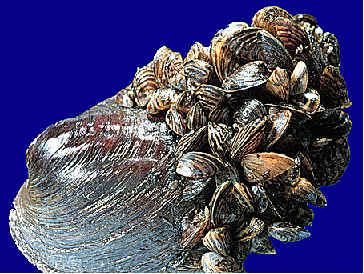Why Are Zebra Mussels Successful As Invaders?
 The zebra mussel (Dreissena polymorpha) is a small, non-native mussel originally found in Russia. In 1988, this animal was transported to North America in the ballast water of a transatlantic freighter and colonized parts of Lake St. Clair. In less than 10 years, zebra mussels spread to all five Great Lakes and into the Mississippi, Tennessee, Hudson, and Ohio River Basins. Many inland waters in Michigan are now infested with zebra mussels. Only one lake was infested in 1992; today there are over 100. Zebra mussels are very successful invaders because they live and feed in many different aquatic habitats, breed prolifically (each female produces 1 million eggs per year), and have both a planktonic larval stage and an attached adult stage.
The zebra mussel (Dreissena polymorpha) is a small, non-native mussel originally found in Russia. In 1988, this animal was transported to North America in the ballast water of a transatlantic freighter and colonized parts of Lake St. Clair. In less than 10 years, zebra mussels spread to all five Great Lakes and into the Mississippi, Tennessee, Hudson, and Ohio River Basins. Many inland waters in Michigan are now infested with zebra mussels. Only one lake was infested in 1992; today there are over 100. Zebra mussels are very successful invaders because they live and feed in many different aquatic habitats, breed prolifically (each female produces 1 million eggs per year), and have both a planktonic larval stage and an attached adult stage.
Young zebra mussels are planktonic. They are the size of the diameter of a human hair and are invisible to the naked eye. Because young zebra mussels are so small, they are spread easily by water currents and can drift for miles before settling. Adult zebra mussels are larger (<2 inches in length) and attach to hard objects and remain stationary. They often attach to objects involved in human activities, such as boats and boat trailers, and are inadvertently moved from one water body to another by people.
The issue of biological control has frequently been raised as a natural means to destroy zebra mussels. To date, no biological control methodology is available, although efforts are underway by various researchers to develop such a species-specific control agent. Release of predators such as black carp that would eat zebra mussels has often been recommended but would be ineffective. Many native animals already in the Great Lakes eat zebra mussels and in some areas are reducing mussel numbers. The problem is one of scale. The lakes are so large and zebra mussels so prolific that, like cockroaches, zebra mussel continue to survive. Zebra mussels may ultimately suffer population loss through loss of food. Massive amounts of food are required to support high population densities of zebra mussels, and planktonic food supplies have declined over the last decade.
Fact Credit
USGS General


